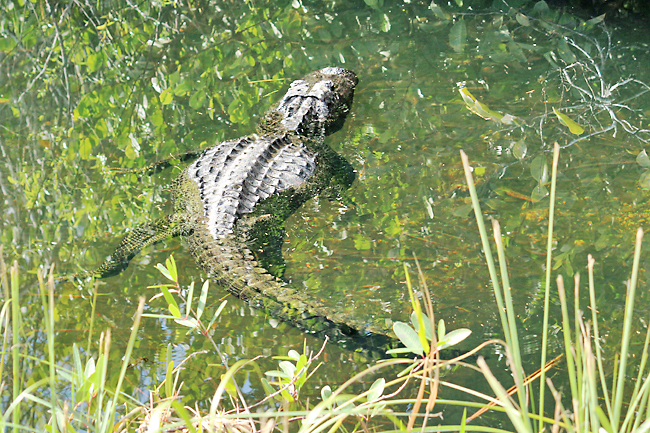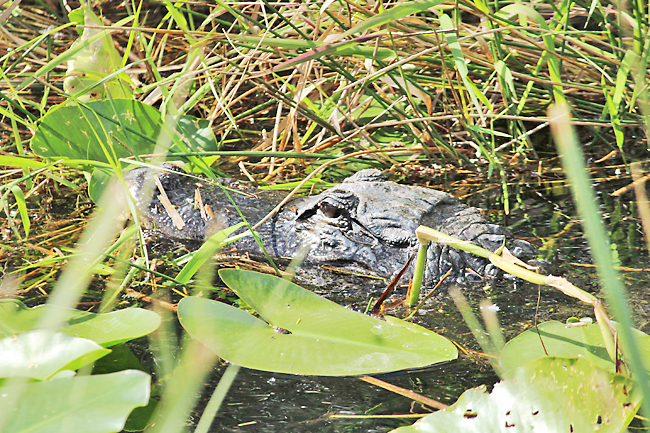Diane Daniel
THE WASHINGTON POST – That can’t be real. Of course it’s real. This is a national park known for alligators. Do you think they’re going to have a fake one at the entrance of a trail?
But it’s so big! Maybe it’s a statue to let people know what to look for?
Those thoughts spun through my mind as we cycled from the parking area to the 15-mile loop at Shark Valley Visitor Center in Everglades National Park in South Florida.
Upon closer inspection – but not too close – I concluded that the alligator was definitely real. About eight feet long and lying in the grass alongside the trail, it was a scaly harbinger of things to come.
My early-January visit was my second in 30 years. All I remembered from before was that the trail was paved, that there was a lookout tower at the end and that I’d had to cycle around (and I mean way around) a sunbathing alligator that was blocking my path. That left a lasting impression.
This time my wife was with me, and I’d all but promised her we’d see alligators.
We had only 24 hours to spend in the Everglades and were determined to see as many of the prehistoric-looking creatures as possible. Such a vow is much easier to keep during the dry season, December through April, so I intended to try.



I’ve lived on and off in Florida’s Tampa Bay area for some 50 years, so I’ve admired occasional alligators along riverbanks, in lakes and even on golf courses.
I have a healthy fear of them and would never swim in fresh or brackish water, nor walk my dog along a lake or canal.
But Shark Valley, much farther south and inside a 1.5-million-acre wetlands preserve, is on
another level.
Only about one hour west of downtown Miami and about 90 minutes southeast of Naples, it’s chock full of gators, which you can easily spot while biking, hiking or going on the park’s two-hour narrated tram tour.
“But is it safe?” you ask.
Human conflicts with alligators are rare and generally not serious.
Most alligator attacks on humans are attributed to illegal feeding, which makes the animals bolder and more likely to attack rather than flee, according to the National Park Service.
Over the past 10 years, the entire state of Florida, thought to have about 1.3 million alligators, has averaged eight unprovoked bites per year – bites serious enough to require medical treatment – according to the Florida Fish and Wildlife Conservation Commission.
Between 1948 and 2021, only 26 unprovoked biting incidents have been deadly.
The likelihood of being seriously injured during an unprovoked alligator incident in Florida is roughly one in 3.1 million, according to the wildlife commission. In other words, the odds are greatly in your favour.
Shark Valley and the much shorter (0.8-mile) Anhinga Trail at Royal Palm’s Ernest F Coe Visitor Center in Homestead are considered the prime gator-viewing trails in Everglades National Park.
If you’re comfortable riding 15 miles on a bicycle, that’s the best way to see the sights at Shark Valley, because you’re able to complete the loop and stop where and when you want.
You can bring your own bike or rent coaster-style bikes from the park concessionaire. On the other hand, the benefit of the tram tour is the ongoing narration by a park naturalist.
The loop goes in both directions. We were lucky to start counterclockwise, with a canal on our right side, meaning it was easier to scan the waterways while riding.
Of course, a guaranteed way to spot gators is to stop where other visitors are congregating with their cameras clicking. My wife, an obsessive photographer, started off shooting every gator we encountered. Some were in the water, some lazing near it and others resting closer to the trail.
By the time the count reached 20 or so, she was only stopping for the big guys or the cute little babies, which pile onto each other like puppies. We gave up on counting at about 50. In the canals, we also loved seeing rows of sunning turtles, as well as majestic shorebirds, including egrets, several types of herons, a wood stork and anhingas, their wings outstretched to dry. Clusters of wildflowers bloomed here and there, along with cheerful, white “swamp lilies”.
On the other side of the path were fields of swaying saw grass and hardwood hammocks – dense stands of broad-leafed trees that grow on a slight rise of only a few inches.
At the 65-foot-tall Shark Valley Observation Tower, we enjoyed panoramic views over the Everglades and of the cyclists moving along the ribbon of trail below.
On the way back, we saw several more alligators in the grass, including one not far off the trail that opened its jaws as we gaped in its direction. We assumed it was smacking its lips, but we later learned that’s how they cool down.
We also saw gator dung, which we recognised from an exhibit at the visitor centre. Final estimated gator count? Maybe 70. At any rate, too many to keep track. On the way to Everglades City, farther west and where we’d stay for the night, we stopped at Clyde Butcher’s Big Cypress Gallery in Ochopee. Butcher, a landscape photographer, is to the Everglades what Ansel Adams was to Yosemite.
His large-format black-and-white wilderness scenes moodily capture the Everglades’ wonder and fragility.
At the gallery, open daily, visitors can purchase prints and gifts, as well as sign up for a swamp walking tour. In Everglades City, which has a population of about 425, we checked in to our motel, then raced down to even tinier Chokoloskee to catch the sunset over the bay.
Early the next morning, we met Meg Chamberlain, aka. Ranger Meg, a kayak guide with Everglades Adventures. From spring to fall, she’s a park ranger and naturalist in Montana.
We’d booked the first tour out, at 7.30am, hoping to see more wildlife and fewer people.
Chamberlain took us and our fellow paddlers, a couple visiting from California, to a roadside launch at Turner River.
This popular paddling destination includes open ponds, mangrove tunnels and saw grass fields.
Although this was only Chamberlain’s first full season in the Everglades, she’d already become a crack gator spotter.
Not long after we’d launched, she pointed out a smallish alligator with its snout just sticking out of the water, which I would have missed.
We marvelled at the birds, cypress trees, orchids and bromeliads. Chamberlain said visitors are usually surprised to find such variety in a swamp. The highlight was paddling through a mangrove tunnel, where branches are so thick and low that it’s easier to push yourself off them than to use a paddle. Over the course of the three-hour tour, the gator count came in at just under a dozen, with some in the water and others on land.
Chamberlain later told me she’d been a little nervous when starting the job, but figured if she could co-exist with grizzly bears, she could handle alligators.
“As you learn more about their behavior, you feel more comfortable,” she said. “Still, it’s important to keep a healthy level of fear.”
The Californians, both experienced kayakers, had made a few half-joking comments about getting eaten by gators along the way. I found out after the tour that they’d been more than a little nervous.
“Before the paddle, we had serious trepidation,” said Andrew Smothers. “It’s probably not a good idea to Google ‘alligator kayak attacks’ the night before your first paddle with them.”
The tour quelled their fears.
“We realised they are mostly calm sunbathers and not aggressive,” he said. “After the tour, I was on a high the rest of the day. I’d totally do it again.”
Heading home, we stopped at the Big Cypress Bend Boardwalk at Fakahatchee Strand Preserve State Park to see virgin cypress trees and mellow out before the drive north. When we got back to the parking area, a group from New York was huddled near a canal.
“Look, there’s an alligator!” one young man called out to me.
I stopped myself from saying, “Been there, done that.”
Instead, I directed him to Shark Valley to see more. Many, many more.


